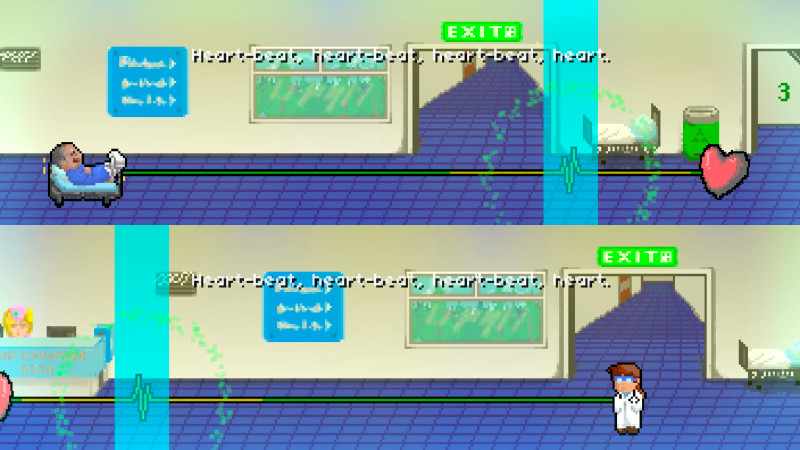Rhythm Doctor‘s catchy riffs and clever one-button gameplay have mesmerized a few notable indie game events this year. It was an official nominee at IndieCade and earned a spot at Double Fine’s Day of the Devs festival. It also won the award for best audio at the Indie Prize Showcase in Asia, the Busan Indie Connect Festival, and more. Though these particular accolades are recent, it’s been a six-year journey for 7th Beat Games, the three-person studio behind the innovative rhythm game.
Now it’s nearing completion, with plans to release its debut for PC, Mac, and iOS and Android devices in the first half of 2018.As the name might imply, Rhythm Doctor’s story takes place in a hospital. You play as an intern who’s in charge of a remote defibrillator. While the music plays, you press the button on every seventh beat. The visuals echo the theme as the song dances along a line, pulsing like a heart monitor. Then the system begins acting strangely, infected by a virus that glitches out the screen and even affects the music. That’s when the real challenge begins. The concept is straightforward, but the gameplay gets its hooks in fast, especially as 7th Beat has just added co-op play. The one-button mechanic draws inspiration from Nintendo’s touchscreen-based Rhythm Heaven, as well as the desire to make the game accessible to folks who are visually impaired.
Programmer and musician Hafiz Azman came up with the idea when he was a university student, and he partnered with his friend and classmate, artist Winston Lee. They submitted it to Independent Games Festival’s student showcase and was accepted — though they almost didn’t make it. Azman says that he woke up from crashing after an all-nighter and realized they needed a trailer to be eligible for the showcase.
He threw something together, and a mere second after he turned in Rhythm Doctor, the submissions closed.“It was one of those moments where I can look back and know that if I had woken up 5 seconds later, I would not be a game developer today,” said Azman in an interview with GamesBeat. “Literally one refresh after I submitted, the page updated to say that entries had closed. That lucky break led to the IGF nomination which then led us to seriously considering continuing developing this game after we graduated.”

Giacomo Preciado joined last year to help with the code after he and Azman connected at the Game Developers Conference industry event in 2014. The three are a remote team, as Azman and Lee are based in Malaysia and Preciado in Peru.
When Azman first conceived of Rhythm Doctor, he thought for sure it was going to fail. He shared with me some of the entries from his developer diary back in the early days. It took him 100 hours to put together an early prototype in 2011. And in 2012, he took the plunge and released a public demo.
“This moment has been two years coming now,” Azman writes. “I’m about to release a demo of my first game. It’s called Rhythm Doctor. My long-time college friend Winston is doing the graphics. And statistically, it’s going to bomb big-time.”
But it doesn’t. It grabs the attention of John Polson, then-editor-in-chief of IndieGames.com, who’s now a senior business developer at Humble Bundle. It gets a writeup on Eurogamer, and it trends in the web gaming section of the social media site Reddit. When 7th Beat released a requested level editor tool, fans created around 400 custom levels, some of which the studio paid to include in the final game.
“It’s hilarious and at the same time I feel like the biggest fake in the industry, ever,” writes Azman in his dev log after Polson asked him if he was going to GDC. “But what I do know is that right now, I feel I’ve earned the right to call myself a game developer. I want to shout it out to the world. Guys, I’m a game developer!”
Here is an edited transcript of our interview.
GamesBeat: What was the inspiration for Rhythm Doctor? Can you tell me more about the story?
Hafiz Azman: In short, the setting is that the player is playing as literally themselves, sitting at their computer, controlling the game. It’s long been known that exciting the heart beat of a patient in perfect synchronization with their natural resting heart rate can heal certain afflictions in patients. What computers have not been able to do yet is execute millisecond-perfect defibrillation. Instead, hospitals are recruiting people selected for their mastery of rhythm, to control their defibrillators via the Internet. The player is one such person.
Through the story, they get to know the doctors in the hospital they are working at, and help them at their jobs. The hospital is underfunded and pay is being cut, so everyone is just trying to get by.
The story itself is heavily inspired by stories from doctor friends about their lives, of burnout and staff shortages, of not being able to spend as much time as they’d like with patients because of the workload….
The post The IndieBeat: How Rhythm Doctor was 1 second away from losing its pulse appeared first on FeedBox.